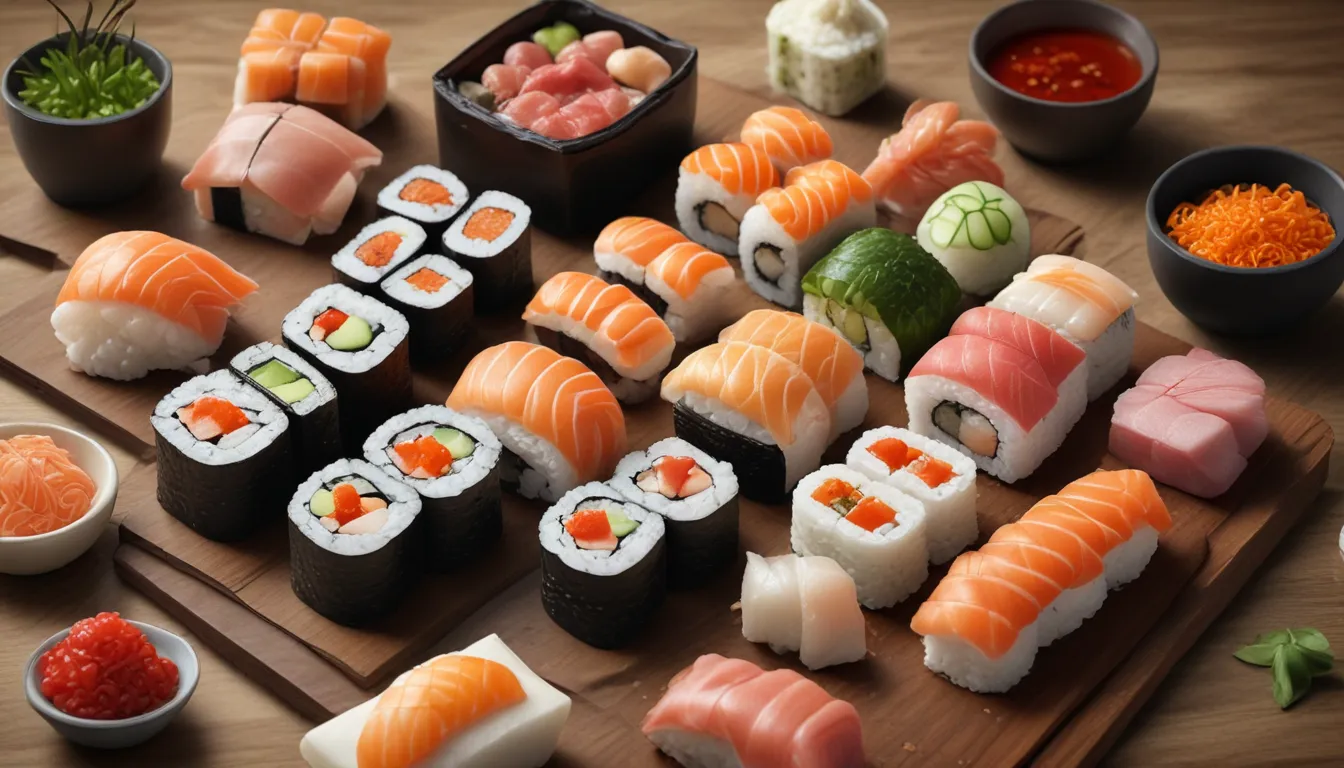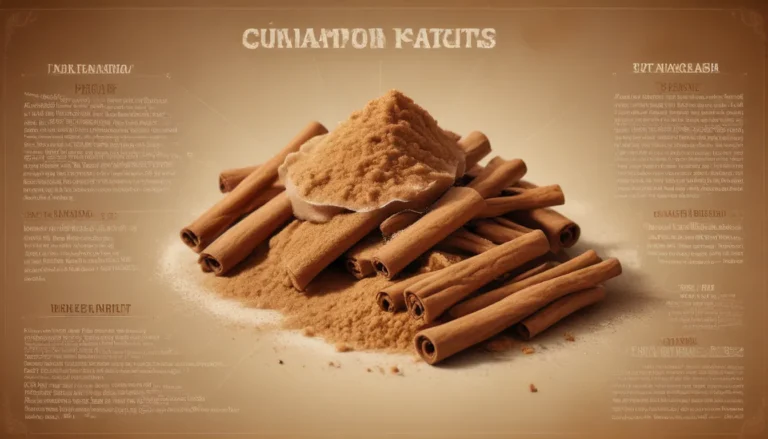The pictures in our articles might not always show exactly what the text is talking about. We use these images to make the article more interesting and eye-catching. They are there to add to the text, but not to replace it or show every detail.
Welcome to the fascinating world of sushi, where tradition meets innovation in every bite. Join us as we uncover intriguing facts about sushi that will captivate both seasoned sushi lovers and newcomers alike. From its ancient origins to modern-day trends, sushi has a rich history and a vibrant present that will leave you craving more.
Unveiling the Ancient Roots of Sushi
Sushi, a staple of Japanese cuisine, actually has its origins rooted in Southeast Asia around the 2nd century AD. Initially used as a method to preserve fish, sushi evolved over time to become the beloved dish we know today. The concept of fermenting fish with rice originated in this region and made its way to Japan, where it transformed into the sushi we recognize today.
The Evolution of Sushi: From Edo Period to Nigiri Sushi
The Edo period in Japan (1603–1868) marked a significant turning point in the history of sushi. It was during this time that ‘nigiri sushi’ was born, featuring a delicate slice of raw fish atop vinegared rice. This style of sushi laid the foundation for the modern variations we enjoy today, showcasing the artistry and precision that sushi chefs are known for.
Distinguishing Sushi from Sashimi: A Culinary Delight
While sushi and sashimi are often grouped together, they are distinctly different. Sushi encompasses any dish that includes vinegared rice, while sashimi consists of thinly sliced raw fish or seafood served on its own. Both delicacies offer a unique taste experience, showcasing the diverse flavors of Japanese cuisine.
The Fine Art of Sushi Consumption
Traditionally, sushi is meant to be consumed in a single bite, allowing the harmonious blend of flavors and textures to be fully appreciated. This practice not only showcases the skill of the sushi chef but also ensures that the culinary experience is enjoyed as intended.
Unveiling the Secrets of Sushi Chefs
Sushi chefs, also known as ‘itamae’, undergo rigorous training that can span over a decade. Apprenticeships focus on mastering the art of preparing rice, a crucial element in sushi making. The dedication and precision required to become a sushi chef are a testament to the craftsmanship and tradition that define sushi culture.
Global Spread of Sushi: A Culinary Phenomenon
Sushi made its way to the United States in the early 20th century, with the first sushi bar opening in Los Angeles in the 1960s. Today, sushi has become a global culinary phenomenon, with each region adding its own unique twist to this traditional dish. Whether you're in Tokyo or New York City, you can savor the flavors of sushi in all its diversity.
Seasonal Delights: Exploring the Freshness of Sushi
In keeping with Japanese culinary traditions, sushi ingredients often vary with the seasons. This emphasis on freshness ensures that each bite of sushi reflects the bounty of the season, highlighting the natural flavors and textures of the ingredients. From spring cherry blossoms to autumn harvests, sushi captures the essence of each season.
Bluefin Tuna: A Jewel of Sushi Cuisine
Bluefin tuna, known as ‘hon-maguro’, is highly prized in sushi cuisine, particularly the fatty belly portion called ‘otoro’. While bluefin tuna is a delicacy, concerns about overfishing have prompted chefs to seek sustainable alternatives to protect this prized species for future generations.
The California Roll: A Western Twist on Sushi
The California roll, a popular sushi choice in the United States, showcases the influence of Western flavors on traditional Japanese cuisine. This roll, created in Los Angeles, features a delightful combination of avocado, crab meat, and cucumber, offering a fresh and flavorful twist on classic sushi.
Unveiling the Mystery of Wasabi
Wasabi, a staple condiment in sushi restaurants, is often a blend of horseradish, mustard, and green food coloring. True wasabi is a rare delicacy due to the challenging cultivation process, making it a prized addition to any sushi experience. The pungent heat of wasabi adds depth and complexity to sushi dishes, enhancing the overall flavor profile.
Navigating the Etiquette of Soy Sauce
Sushi etiquette emphasizes the delicate balance of flavors when enjoying this iconic dish. It is recommended not to over-soak your sushi in soy sauce, as this can overpower the subtle flavors of the fish and rice. A light touch of soy sauce allows the quality of the ingredients to shine through, ensuring a truly satisfying sushi experience.
Exploring the Importance of Rice in Sushi
Contrary to popular belief, sushi does not solely refer to raw fish. The term ‘sushi’ actually translates to ‘sour-tasting’, highlighting the significance of vinegared rice in this culinary art form. The quality of rice used in sushi plays a crucial role in its overall taste and texture, making it an essential component of this beloved dish.
Sushi Beyond Savory: Sweet Varieties
While sushi is typically enjoyed as a savory dish, it can also be crafted into sweet creations for those with a sweet tooth. In Japan, chefs occasionally experiment with fruit and other sweet ingredients to create unique sushi desserts that offer a delightful balance of flavors. Whether savory or sweet, sushi continues to surprise and delight food enthusiasts around the world.
Unveiling the Nutritional Benefits of Sushi
Sushi offers a range of nutritional benefits, depending on the ingredients used. Raw fish is a rich source of protein and omega-3 fatty acids, while vegetables provide fiber and essential vitamins and minerals. This nutrient-packed combination makes sushi a wholesome and satisfying meal choice for health-conscious individuals.
Conveyor Belt Sushi: A Modern Innovation
In 1958, the first conveyor belt sushi restaurant, known as ‘kaiten sushi’, revolutionized the sushi dining experience in Japan. This innovative concept made sushi more accessible and affordable, allowing diners to sample a variety of fresh dishes as they circulate along a conveyor belt. Conveyor belt sushi has since become a popular dining option worldwide, offering a fun and interactive way to enjoy sushi.
Vegetarian and Vegan Sushi: A Plant-Based Delight
Sushi isn't just for seafood enthusiasts – many sushi restaurants offer vegetarian and vegan options that cater to a plant-based diet. Ingredients like avocado, cucumber, pickled vegetables, and tofu are used to create flavorful and satisfying vegetarian sushi rolls, showcasing the versatility and creativity of sushi chefs. Whether you're a devoted vegetarian or simply looking to explore new culinary horizons, vegetarian sushi offers a delightful and nutritious dining experience.
Sushi: From Affordable to Luxurious
While sushi can be enjoyed on a budget, it can also be a luxurious indulgence for special occasions. The world's most expensive sushi, crafted by chef Angelito Araneta Jr., features extravagant ingredients like gold leaf, diamonds, and pearls, elevating sushi to a lavish dining experience fit for royalty. Whether you prefer a simple sushi roll or a decadent sushi masterpiece, there is a sushi option for every palate and budget.
Unveiling the Artistry of Sushi Knives
Sushi chefs wield a variety of specialized knives that are essential to their craft. Some sushi knives are crafted from the same high-quality steel used to make traditional samurai swords, requiring meticulous care and maintenance to ensure their sharpness and precision. The artistry of sushi knives reflects the dedication and skill of sushi chefs, who take pride in every slice and cut to create perfectly crafted sushi creations.
Savoring Sushi for Breakfast
In Tokyo's renowned fish market, Tsukiji, sushi for breakfast is a common tradition among locals and visitors alike. Enjoying sushi for breakfast allows diners to savor the freshest catch of the day, highlighting the unparalleled quality and freshness of the ingredients. Whether you start your day with a traditional sushi breakfast or indulge in sushi for lunch or dinner, the flavors and textures of sushi are sure to delight your taste buds.
Embracing Sushi Robots: A Blend of Tradition and Technology
As technology continues to advance, sushi-making has embraced innovation with the introduction of sushi robots. These automated machines can produce up to 300 pieces of sushi in an hour, showcasing the fusion of tradition and technology in the culinary world. While sushi robots may streamline the sushi-making process, they complement the artistry and precision of sushi chefs, ensuring that each sushi roll is crafted with care and precision.
A Final Invitation to Explore the World of Sushi
Embrace the art, tradition, and innovation that define sushi as a globally beloved dish. Whether you're a seasoned sushi enthusiast or a newcomer to this culinary delight, there's always more to learn, taste, and explore in the world of sushi. From ancient origins to modern trends, sushi offers a culinary journey filled with flavors, textures, and experiences that will tantalize your senses and leave you craving more.
Explore, Learn, and Taste the World of Sushi
As you embark on your culinary journey through the world of sushi, remember to savor each bite, appreciate the artistry of the sushi chef, and embrace the diverse flavors and traditions that make sushi a global favorite. Whether you prefer classic nigiri sushi or innovative sushi creations, the world of sushi invites you to explore, learn, and taste the rich tapestry of flavors that define this iconic dish.






